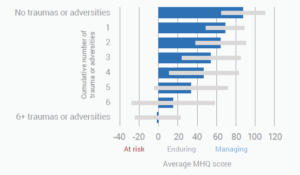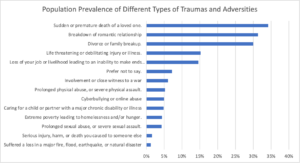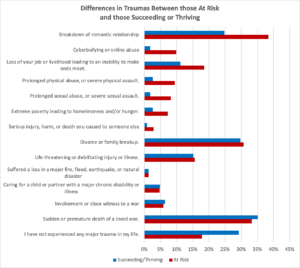Across the population, the more traumas one experiences, the greater the challenge to mental wellbeing. Moreover, different types of traumas and adversities have substantially different impact.
Many mental health disorders are associated with, or triggered by, challenging or stressful life experiences. Early childhood is an especially vulnerable period [1-4] and cumulative traumas over the lifespan also take a considerable toll on people’s mental wellbeing. Recent data from the Global Mind Project found that mental wellbeing, as measured by the MHQ score, declined systematically with the experience of more adversities and traumas over the lifetime, consistent with other reports [5,6]. One might consider the analogy to physical injury where repeated injuries over a lifetime from broken bones to muscle tears might heal but leave the body physically compromised and less capable than before the injury. Thus while some degree of life adversity is said by some to make people more resilient, more often it’s the case that these distressing experiences have a serious impact on people’s mental wellbeing over the long-term.

Impact of cumulative trauma and adversity on mental wellbeing.
The prevalence of different traumas and adversities.
Across a respondent population of ~130k, 76% had experienced at least one trauma or adversity in their lifetime. Across 14 types of adversities and traumas queried in the data, the most commonly experienced were sudden or premature death of a loved one (34%), breakdown of a romantic relationship (31%) or divorce/family breakdown (30%).
See related post Predicting Mental Wellbeing from Life Circumstance

Prevalence of difference traumas and adversities across the whole population of respondents
The pattern of prevalence varied slightly across age groups and genders. For those aged 18-24, the prevalence of cyberbullying was higher at 13% compared to the overall population prevalence of 4%. As might be expected the prevalence of divorce/family breakdown and sudden/premature death of a loved one increased over successive age groups, while financial adversities (e.g. job loss, inability to make ends meet) were most commonly experienced by those aged 25-44.
Across the gender groups, the prevalence of sexual and physical abuse was higher in females (5.7%) compared to males (2%), but even higher in those who were non-binary/third gender (16%). Non-binary/third gender individuals, compared to both males and females, were also much more likely to report having experienced cyberbullying (30%), the breakdown of a romantic relationship (42%) or extreme poverty (11.5%).
See related post: The Gender Gap in Mental Wellbeing
Trauma, adversity and mental wellbeing.
Here we show a comparison of the prevalence of traumas and adversities between people who had at risk MHQ scores (indicating that they were experiencing clinical level challenges) with those who had high MHQ scores (indicating that they were succeeding/thriving). Interestingly, certain traumas were almost equally prevalent across both groups while others had large disparities.
Those at risk for mental health challenges were several-fold more likely than those succeeding or thriving to have experienced physical and sexual abuse, extreme poverty with homelessness or hunger or have caused serious harm or injury to others. They were also substantially more likely to have experienced a breakdown of romantic relationships and job loss. On the other hand, challenges such as divorce or family break-up, sudden or premature death of a loved one and life threatening or debilitating illness or injury were equally common across both groups

This suggests that different traumas have different effects. Untangling the impact of different life traumas and adversities, and the direction of causality between trauma and mental health is crucially important for developing effective strategies for both prevention and treatment.
















